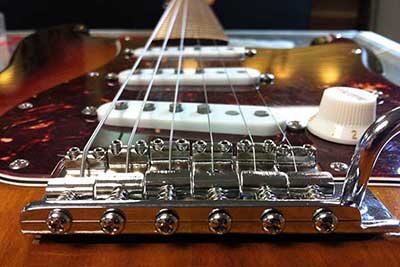
You have a guitar you have either had for a while or just purchased. You are thinking “I just purchased this guitar.” It was just made do I really need to get it set up? I used to think all setting up a guitar did was adjust the intonation, straighten the neck and push some of the frets in that need it. There is so much more in properly setting up a guitar. I am not going to get into how to perform this here. There are plenty of youtube videos on many specific guitars. Taking a guitar to a professional is not that expensive and I always recommend this option if available to the player. So, what does this actually do? Well like I said earlier Your intonation is set and the neck is straightened but there is so much more. The radius of the nut and bridge is also set. When guitars come from the factory the nuts are usually just pre-made and glued on the guitar. They are either made of plastic, delrin, bone or brass. I prefer bone or brass over plastic or Delrin (which is a form of plastic just higher end then normal plastic). The tone of the guitar seems to come though a bit more with these nuts. This can be debatable though. When you fingers are pushing on the strings do you really hear the nut? Some say yes, some say no. In the grand total of the guitar the nut material makes a difference, but it is a very small difference. What does matter in the nut it how the strings sit on it. When your guitar is set up the Luther can file down slots in the nut to make the strings individually sit at the right height to the fretboard. If the slots are too low the nut can either be shimmed or filled to raise the height of the slot. Though filling is not permanent and wears down over time. In this case the nut can be replaced as needed.
The saddle is also matched to the radius of the guitar. In the case of Strats, Teles (modern ones) and most basses each individual saddle can be raised to lowered to match the heights of the radius. With bridges like Les Pauls or SG bridges only the low E and high E can be set. The rest is set by filling down the slots in the remaining saddles. This is not something you want to perform yourself as you can really mess a bridge up if done wrong. Other general things on the guitar will also be performed. Like the pickup height will be set, the fretboard oiled and the pots, jack and 3-way switch being cleaned. Every guitar is different, but this is generally what is done on a working guitar.
Now let’s talk about upgrades. The most common upgrade people do is the pickups. There are generally 3 categories of pickups. Cheap ones that come on a guitar (though the ones that come on the guitar can be any of these three), higher end ones from your guitar manufacture (like Gibson, Fender etc) and then boutique companies that only make pickups. Cheap ones are just that. Cheap pickups that will under-perform pickups from the other two categories. Now what should you buy high end pickups from Gibson or Fender or boutique pickups. Some people swear by Gibson Classic 57s or Burstbuckers. These are much better pickups that lower end stock ones. I have found Gibson Classic 57s to be a bit muddy sounding vs boutique companies like Lindy Fralin. They are close, but I always think boutique companies like Fralin pickups sound better. I would put Seymour Duncan pickups in the same class as Gibson or Fender. I think other boutique companies for the same price make better pickups than Duncan does but this is down to personal preference and every user will think different.
So, you decided to change your pickups should you just stop there? Your pots and tone caps will also make a very big deference. CTS pots are pretty much the standard with guitars and basses. If you have cheap pots replacing them with CTS pots will make a big deference. But you should also change the wire and tone caps. The three most common type of tone caps are cheap small ceramic ones, orange drop caps and paper in oil caps. Small ceramic caps will have the least effect when rolling off the tone. They seem to only effect a small amount of the tone and do not do a broad sweep like the other two do. Orange Drop caps are very popular and sound much broader than the small ceramic ones do. Paper in Oil caps (PIO) are found in most vintage guitars and give you the classic vintage tone. These are very popular in Les Paul’s, Strats and so on. There is a very wide price range for PIO caps ranging from $10-$100+. Some companies make re-issue PIO caps and sell them for $100+. Is there a difference between those and the mid-grade ones for $18 or so for a set? Most people say no. But I am sure there are a few that can tell the difference. I think this is a very small difference and not worth the extra money but that is up to you to decide for yourself though.
The next thing you can do for your guitar and not all guitars need this. Is shielding the guitar. If you pay someone to do this it can be very expensive. If you do this yourself it will be under $7 or so. For new pickups and Pots you will need soldering skills and let’s face it not everyone has them. For the most part shielding can be done without soldering. Though you may have one or two solder points that you will need to remove if you shield your guitar. There is a video posted at the end of the article about shielding. What does shielding actually do? When you take you hands off of the strings is there a buzz? When you play in a bar that has florescent lights or bad power does your guitar make weird buzzing or sounds when you move around? These all may be signs of a guitar in need to shielding. Do not confuse this with single coil magnetic field noise. This is just a part of single coil picks as you move left to right and as you pull the body of the guitar from parallel to perpendicular there will be a phase sound. Shielding will not get rid of this but will only get rid of the constant buzz that happens all the time no matter what direction you are facing. Shielding creates a Faraday cage around the electronics of the guitar and blocks the + single from interacting with other electric elements that are in the room. Remember speakers sitting next to old TV’s years ago. They would create a blue image in the TV when the speaker got too close. If the speaker was shielded like a guitar can be this would not happen as the Faraday cage blocks the interference.
You can also upgrade you bridge and tremolo (if available) on your guitar. This can be a big improvement in the sustain of the guitar. Then there are cosmetic things like knobs and so on. You can also add new tuners. Personally, I love locking tuners and have them on most of my guitars. These can help your guitar stay in tune better and you can change strings in a matter on minutes. Best thing is you do not need to spend hours stretching the strings out anymore.
In a nutshell this covers upgrading and setting up your guitar. There are plenty of videos and articles online that go into greater detail about the specific item mentioned above. Finding a good guitar tech is key. Search your area and read reviews, talk to you fiends and find the guy that is right for you. If you are in the Brea area as I am you could try Rick Graham at the Guitar Repair shop (714) 256-4340. All the guitars at A-Room Studios have been professionally set up and have had their pickups and electronic replace as needed.
Shielding link:
